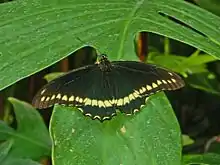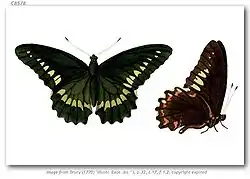Battus polydamas
Battus polydamas, also known as the gold rim swallowtail, the Polydamas swallowtail or the tailless swallowtail, is a species of butterfly in the family Papilionidae. The species was first described by Carl Linnaeus in his 10th edition of Systema Naturae, published in 1758.
| Battus polydamas | |
|---|---|
 | |
_underside_worn_2.JPG.webp) | |
| B. p. jamaicensis | |
| Scientific classification | |
| Kingdom: | Animalia |
| Phylum: | Arthropoda |
| Class: | Insecta |
| Order: | Lepidoptera |
| Family: | Papilionidae |
| Genus: | Battus |
| Species: | B. polydamas |
| Binomial name | |
| Battus polydamas | |
| Synonyms | |
| |
Description
The wingspan is 90 to 120 mm (3.5 to 4.7 in) without the tail. The top of the wings are black with a broad submarginal band formed by large yellow spots. The undersides of the forewings have the same pattern, while the hindwings have a submarginal row of red lunules. This butterfly flies from April to November in three generations in the north of its range, throughout the year in several generations in the tropics. The larvae feed on Aristolochia plant species.
Distribution
It is found in the Neotropical realm of South America, the southeastern U.S., and Mexico.[2]
Habitat
Battus polydamas is mainly present in open woods and abandoned fields.
Subspecies
The species is divided into the following subspecies:

- †B. p. antiquus (Rothschild & Jordan, 1906) – Antigua
- B. p. archidamas (Boisduval,1836) – Chile
- B. p. atahualpa Racheli & Pischedda, 1987 – Peru
- B. p. cebriones (Dalman, 1823)
- B. p. christopheranus (Hall, 1936)
- B. p. cubensis (Dufrane, 1946) – Cuba
- B. p. dominicus (Rothschild & Jordan, 1906) – Dominica
- B. p. grenadensis (Hall, 1930)
_underside_J.JPG.webp)
- B. p. jamaicensis (Rothschild & Jordan, 1906) – Jamaica
- B. p. lucayus (Rothschild & Jordan, 1906) – Bahamas
- B. p. lucianus (Rothschild & Jordan, 1906) – St. Lucia
- B. p. neodamas (Lucas, 1852) – Guadeloupe
- B. p. peruanus (Fuchs, 1954) – Peru
- B. p. polycrates (Hopffer, 1865) – Haïti, Dominican Republic
.JPG.webp)
- B. p. polydamas (Linnaeus, 1758) – tropical South America
- B. p. psittacus (Molina, 1782) – Argentina
- B. p. renani Lamas, 1998 – Peru
- B. p. streckerianus (Honrath, 1884) – Peru
- B. p. thyamus (Rothschild & Jordan, 1906) – Puerto Rico, Virgin Islands
- B. p. vincentius (Rothschild & Jordan, 1906)
- B. p. xenodamas (Hübner, 1825) – Martinique[3]
- B. p. weyrauchi Lamas, 1998 – Peru[2]
See also
References
- "NatureServe Explorer 2.0 - Battus polydamas Polydamas Swallowtail". explorer.natureserve.org. Retrieved 20 September 2020.
- Savela, Markku. "Battus polydamas (Linnaeus, 1758)". Lepidoptera and Some Other Life Forms. Retrieved September 16, 2019.
- "Battus polydamas (Linnaeus, 1758)". Catalogue of the Lepidoptera of the French Antilles. Retrieved September 16, 2019.
- Mathew, G. F. (1877). "Life history of Papilio archidamas". Entomologist's Monthly Magazine. 14 (163): 152–153.
- Brown, F. Martin & Heineman, Bernard. Jamaica and its Butterflies. (E. W. Classey, London 1972), plate VIII
- Smart, Paul (1976). The Illustrated Encyclopedia of the Butterfly World in Color. London, Salamander: Encyclopedie des papillons. Lausanne, Elsevier Sequoia (French language edition) ISBN 9780948427046 ISBN 0600313816 page 159 fig. 19 as B. archidamas Bsdv., underside (Chile), fig. 17 as polydamas (Mexico).
External links
| Wikimedia Commons has media related to Battus polydamas. |
| Wikispecies has information related to Battus polydamas. |
- Lotts, Kelly & Naberhaus, Thomas (2017). "Polydamas Swallowtail Battus polydamas (Linnaeus, 1758)". Butterflies and Moths of North America. Retrieved September 16, 2019.
- Polydamas swallowtail on the UF / IFAS Featured Creatures Web site
